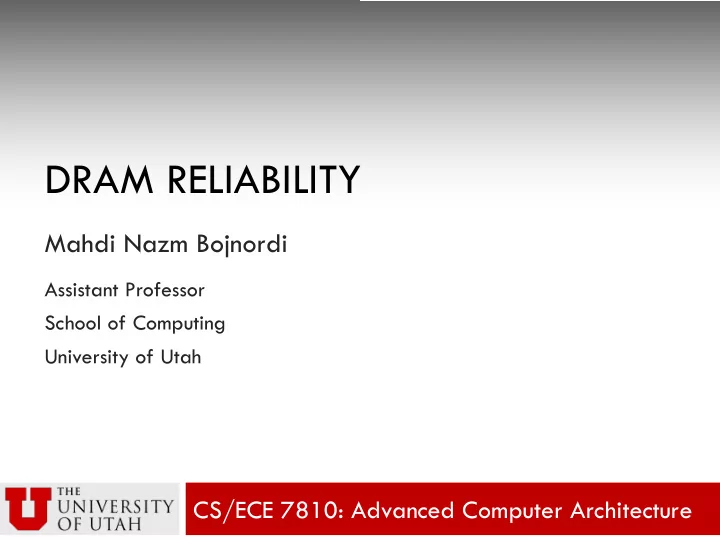

DRAM RELIABILITY Mahdi Nazm Bojnordi Assistant Professor School of Computing University of Utah CS/ECE 7810: Advanced Computer Architecture
Overview ¨ Upcoming deadline ¤ March 4 th (11:59PM): homework ¤ Late submission = NO submission ¤ March 25 th : sign up for your student paper presentation ¨ This lecture ¤ Memory errors ¤ Error detection vs. correction ¤ Memory scrubbing ¤ Disturbance errors
Memory Errors ¨ Any unwanted data change (bit flip) ¤ storage cell ¤ sensing circuits ¤ wires ¨ Soft errors are mainly caused by ¤ Slight manufacturing defects ¤ Gamma rays and alpha particles ¤ Electrical interference ¤ …
Error Detection and Correction ¨ Main memory stores a huge number of bits ¤ Nontrivial bit flip probability ¤ Even worse as the technology scales down ¨ Reliable systems must be protected against errors ¨ Techniques ¤ Error detection n parity is a rudimentary method of checking the data to see if errors exist ¤ Error correction code (ECC) n additional bits used for error detection and correction
Error Correction Codes ¨ Example: add redundant bits to the original data bits ¤ SECDED: Hamming distance (0000, 1111) = 4 Power Correct #bits Comments Nothing 0,1 1 Single error detection 00,11 2 01,10 =>errors (SED) Single error correction 000,111 3 001,010,100 => 0 (SEC) 110,101,011 => 1 Single error correction 0000,1111 4 One 1 => 0 double error detection Two 1’s => error (SECDED) Three 1’s => 1 [adopted from Lipasti]
Error Correction Codes ¨ Reduce the overhead by applying the codes to words instead of bits # bits SED overhead SECDED overhead 1 1 (100%) 3 (300%) 32 1 (3%) 7 (22%) 64 1 (1.6%) 8 (13%) n 1 (1/n) 1 + log 2 n + a little ECC Chip ECC DIMM (9 x8 chips)
Memory Error Correction ¨ ECC allows the memory controller to correct cell retention errors and relax memory cell retention requirements. (1) READ ECC Data (2) Recover ERROR Memory ECC Logic Scrubber (3) Write
Memory Scrubbing Data Bits ECC Bits ¨ ECC can correct a fixed number of errors ¨ Data can become uncorrectable if ECC is used without scrubbing ¨ Scrubbing prevents errors from accumulating over time ¤ Periodically read all of the memory locations Uncorrectable ¤ Check ECC, correct errors, and write corrected data ECC Logic back to memory
Stronger Error Corrections ¨ SECDED Support 64-bit data word 8-bit ECC • One extra x8 chip per rank • Storage and energy overhead of 12.5% • Cannot handle complete failure in one chip
Stronger Error Corrections ¨ SECDED Support ¨ Chipkill Support 64-bit data word 8-bit ECC At most one bit from each DRAM chip • Use 72 DRAM chips to read out 72 bits • Dramatic increase in activation energy and overfetch • Storage overhead is still 12.5%
Stronger Error Corrections ¨ SECDED Support ¨ Chipkill Support 8-bit data word 5-bit ECC At most one bit from each DRAM chip • Use 13 DRAM chips to read out 13 bits • Storage and energy overhead: 62.5% • Other options exist; trade-off between energy and storage
Row Hammer Problem ¨ Repeated row activations can cause bit flips in adjacent rows Wordline Row of Cells Row Victim Vic im Row V HIGH V LO Row Op Opened Cl Closed Ha Hammer ered ed Row LOW HIGH Row Victim Vic im Row Row [Apple]
Modern DRAM is Vulnerable First Appearance
How Program Induces RH Errors? CP CPU DR DRAM M Module le loop: mov ( X ), %eax X mov ( Y ), %ebx clflush ( X ) clflush ( Y ) Y mfence jmp loop
Sources of Disturbance Errors ¨ Cause 1: Electromagnetic coupling ¤ Toggling the wordline voltage briefly increases the voltage of adjacent wordlines ¤ Slightly opens adjacent rows à Charge leakage ¨ Cause 2: Conductive bridges ¨ Cause 3: Hot-carrier injection Confirmed by at least one manufacturer [slide source:Mutlu]
Basic Solutions ¨ Throttle accesses to same row ¤ Limit access-interval: ≥500ns ¤ Limit number of accesses: ≤128K (=64ms/500ns) ¨ Refresh more frequently ¤ Shorten refresh-interval by ~7x Both naive solutions introduce significant overhead in performance and power [Kim’2014]
Probabilistic Adjacent Row Activation ¨ Key Idea ¤ After closing a row, we activate (i.e., refresh) one of its neighbors with a low probability: p = 0.005 ¨ Reliability Guarantee ¤ When p=0.005 , errors in one year: 9.4×10 -14 ¤ By adjusting the value of p , we can vary the strength of protection against errors [Kim’2014]
Recommend
More recommend